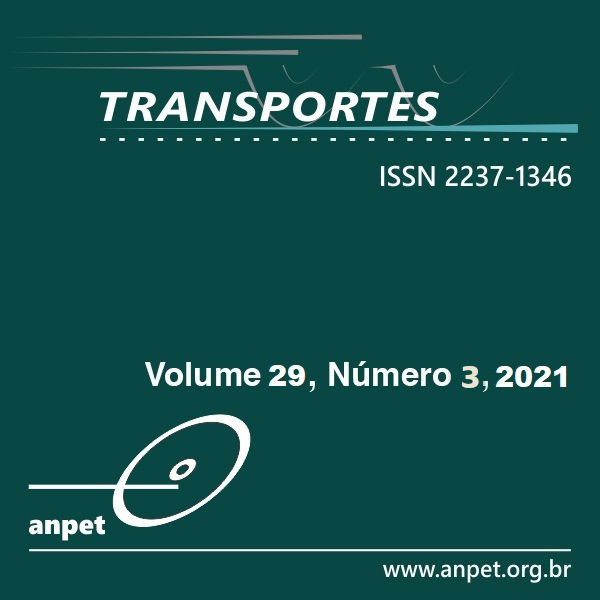Load-sensitive bus headway control for reducing onboard passenger waiting time
DOI:
https://doi.org/10.14295/transportes.v29i3.2650Keywords:
Bus headway control, Variable gain, Public transportAbstract
Regularity in the bus schedule on low frequency lines or the maintenance of headways on high frequency lines are desired in the operation of public transportation. Bus holding is a technique used for this purpose, but it may incur in delays for onboard passengers. Previous work based on a predictive control method identified a better performance when the holding actions were concentrated in stations where the buses were emptier. Based on these results, the forward headway and the two-way headway feedback control methods, both operated with static gains and mathematically and computationally simpler than predictive control, are modified to operate with variable gains according to the bus load using two different techniques. A variable slack, dependent on the bus load, is also incorporated into the controllers. Microsimulations of a BRT corridor with concentrated and distributed demand patterns have shown that the proposed techniques improve the system performance when compared to the corresponding methods with fixed gain.
Downloads
References
AIMSUN (2020) Aimsun Next 8.4 Help Online. Available at <https://www.aimsun.com/>. (Accessed in 11/05/2021).
Barnett, A. (1974) On Controlling Randomness in Transit Operations. Transportation Science, v. 8, n. 2, p. 102-116. DOI: 10.1287/trsc.8.2.102.
Cats, O.; A. Larijani; H. Koutsopoulos e W. Burghout (2011) Impacts of Holding Control Strategies on Transit Performance. Transportation Research Record, v. 2216, p. 51-58. DOI: 10.3141/2216-06.
Ceder, A. (2007) Public Transit Planning and Operation: Theory, Modeling and Practice. Elsevier, Butterworth-Heinemann, Burlington, Massachussetts.
Daganzo, C. F. (2010) Public Transportation Systems: Basic Principles of System Design, Operations Planning and Real-Time Control. ITS Berkeley, Berkeley, California. Available at < https://escholarship.org/uc/item/46f4x3zf >. (Accessed in 11/05/2020).
Eberlein, X. J.; N. H. M. Wilson e D. Bernstein (2001) The Holding Problem with Real-time Information Available. Transportation Science, v. 35, n. 1, p. 1-18. DOI: 10.1287/trsc.35.1.1.10143.
Ibarra-Rojas, O.; F. Delgado; R. Giesen e J. Muñoz (2015) Planning, Operation and Control of Bus Transport Systems: A Literature Review. Transportation Research Part B: Methodological, v. 77, p. 38-75. DOI: 10.1016/j.trb.2015.03.002.
Koehler L.; W. Kraus e E. Camponogara (2011) Iterative Quadratic Optimization for the Bus Holding Control Problem. IEEE Transactions on Intelligent Transportation Systems, v. 12, n. 4, p. 1568-1575. DOI: 10.1109/TITS.2011.2164909.
Lima, L. (2020) Controle realimentado de intervalo entre ônibus com ganho variável de acordo com o carregamento. Dissertação (mestrado). Programa de Pós-Graduação em Engenharia de Automação e Sistemas, Universidade Federal de Santa Catarina. Florianópolis. Available at < https://repositorio.ufsc.br/handle/123456789/216157>. (Accessed in 11/05/2020).
Lima, L.; W. Kraus; R. Carlson e L. Zimmermann (2019) Controlador realimentado de intervalo entre ônibus com ganho variável de acordo com o carregamento. 33º Congresso da Associação Nacional de Pesquisa e Ensino em Transporte.
Newell, G. F. e R. B. Potts (1964) Maintaining a Bus Schedule. 2nd Australian Road Research Board Conference. v. 2, n. 1, p. 388-393. Australian Road Research Board (ARRB), Melbourne.
PLAMUS (2015) Plano de Mobilidade Urbana Sustentável da Grande Florianópolis. Available at <http://observatoriodamobilidadeurbana.ufsc.br/>. (Accessed in 11/05/2020).
Turnquist, M. (1982) Strategies for Improving Bus Transit Service Reliability. Transportation Research Record 818. Evanston, IL: Northwestern University. Available at < https://trid.trb.org/view/174188>. (Accessed in 11/05/2020).
Wright, L. e W. Hook (2007) Bus Rapid Transit Planning Guide. Institute for Transportation & Development Policy, New York. Available at < https://www.itdp.org/2017/11/16/the-brt-planning-guide/>. (Accessed in 11/05/2020).
Zimmermann, L. (2016) Controle de Intervalos entre Ônibus: Comparação entre Métodos Realimentados Clássicos e Controle Preditivo Baseado em Modelo. Dissertação (mestrado). Programa de Pós-Graduação em Engenharia de Automação e Sistemas, Universidade Federal de Santa Catarina. Florianópolis. Available at < https://repositorio.ufsc.br/handle/123456789/175840>. (Accessed in 11/05/2020).
Zimmermann, L.; W. Kraus e L. A. Koehler (2015) Análise de Estratégias Realimentadas para Controle por Retenção do Intervalo Entre Ônibus. 29º Congresso da Associação Nacional de Pesquisa e Ensino em Transporte.
Zimmermann, L.; W. Kraus; L. A. Koehler e E. Camponogara (2016) Holding Control of Bus Bunching without Explicit Service Headways. IFAC-PapersOnLine, v. 49, n. 3, p. 209-214. DOI: 10.1016/j.ifacol.2016.07.035.
Downloads
Published
How to Cite
Issue
Section
License
Copyright (c) 2021 Lucas Franco Lima, Rodrigo Castelan Carlson, Werner Kraus Junior, Lucas Zimmermann, Luiz Alberto Koehler

This work is licensed under a Creative Commons Attribution 4.0 International License.
Authors who submit papers for publication by TRANSPORTES agree to the following terms:
- The authors retain the copyright and grant Transportes the right of first publication of the manuscript, without any financial charge, and waive any other remuneration for its publication by ANPET.
- Upon publication by Transportes, the manuscript is automatically licensed under the Creative Commons License CC BY 4.0 license. This license permits the work to be shared with proper attribution to the authors and its original publication in this journal.
- Authors are authorized to enter into additional separate contracts for the non-exclusive distribution of the version of the manuscript published in this journal (e.g., publishing in an institutional repository or as a book chapter), with recognition of the initial publication in this journal, provided that such a contract does not imply an endorsement of the content of the manuscript or the new medium by ANPET.
- Authors are permitted and encouraged to publish and distribute their work online (e.g., in institutional repositories or on their personal websites) after the editorial process is complete. As Transportes provides open access to all published issues, authors are encouraged to use links to the DOI of their article in these cases.
- Authors guarantee that they have obtained the necessary authorization from their employers for the transfer of rights under this agreement, if these employers hold any copyright over the manuscript. Additionally, authors assume all responsibility for any copyright infringements by these employers, releasing ANPET and Transportes from any responsibility in this regard.
- Authors assume full responsibility for the content of the manuscript, including the necessary and appropriate authorizations for the disclosure of collected data and obtained results, releasing ANPET and Transportes from any responsibility in this regard.









